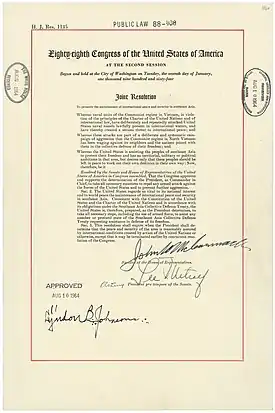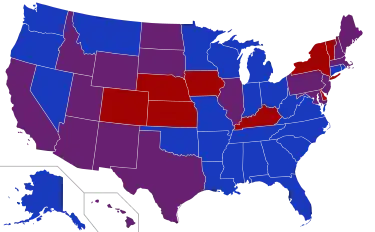88th United States Congress
The 88th United States Congress was a meeting of the legislative branch of the United States federal government, composed of the United States Senate and the United States House of Representatives. It met in Washington, D.C., from January 3, 1963, to January 3, 1965, during the final months of the presidency of John F. Kennedy, and the first years of the presidency of his successor, Lyndon B. Johnson. The apportionment of seats in this House of Representatives was based on the 1960 United States census, and the number of members was again 435 (it had temporarily been 437 in order to seat one member each from recently admitted states of Alaska and Hawaii).
| 88th United States Congress | |
|---|---|
87th ← → 89th | |
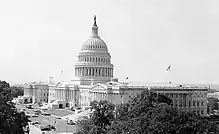 United States Capitol (1962) | |
January 3, 1963 – January 3, 1965 | |
| Members | 100 senators 435 representatives |
| Senate majority | Democratic |
| Senate President | Lyndon B. Johnson (D)[lower-alpha 1] (until November 22, 1963) Vacant (from November 22, 1963) |
| House majority | Democratic |
| House Speaker | John McCormack (D) |
| Sessions | |
| 1st: January 9, 1963 – December 30, 1963 2nd: January 7, 1964 – October 3, 1964 | |
Both chambers maintained a Democratic majority - including a filibuster-proof supermajority in the Senate - and with President Kennedy, the Democrats maintained an overall federal government trifecta.
Major events
- November 22, 1963: Vice President Lyndon B. Johnson became President of the United States on the death of President John F. Kennedy.
- March 30 – June 10, 1964: The longest filibuster in the history of the Senate was waged against the Civil Rights Act of 1964, with 57 days of debate over a 73-day period. It ended when the Senate voted 71–29 to invoke cloture, with the filibuster carried out by southern members of the Democratic Party, the first successful cloture motion on a civil rights bill.[1][2][3]
- August 2–4, 1964: Gulf of Tonkin Incident
- November 3, 1964: President Lyndon Johnson is elected to a full term in the 1964 United States Presidential election, defeating Republican nominee Barry Goldwater
Major legislation
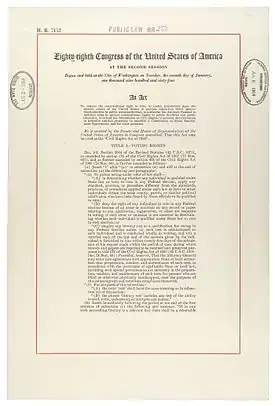

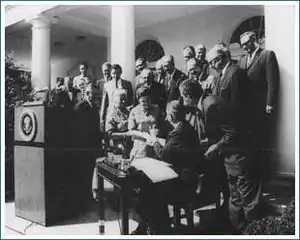
- June 10, 1963: Equal Pay Act, Pub. L.Tooltip Public Law (United States) 88–38
- October 17, 1963: Department of Defense Appropriations Act, Pub. L.Tooltip Public Law (United States) 88–149
- October 31, 1963: Community Mental Health Centers Act, Pub. L.Tooltip Public Law (United States) 88–164, title II, including Mental Retardation Facilities Construction Act
- December 17, 1963: Clean Air Act, Pub. L.Tooltip Public Law (United States) 88–206
- July 2, 1964: Civil Rights Act of 1964, Pub. L.Tooltip Public Law (United States) 88–352
- July 9, 1964: Urban Mass Transportation Act of 1964 (Federal Transit Act), Pub. L.Tooltip Public Law (United States) 88–365
- August 7, 1964: Tonkin Gulf Resolution, Pub. L.Tooltip Public Law (United States) 88–408
- August 20, 1964: Economic Opportunity Act of 1964, Pub. L.Tooltip Public Law (United States) 88–452
- August 31, 1964: Food Stamp Act of 1964, Pub. L.Tooltip Public Law (United States) 88–525
- September 3, 1964: Wilderness Act, Pub. L.Tooltip Public Law (United States) 88–577
- September 4, 1964: Nurse Training Act, Pub. L.Tooltip Public Law (United States) 88–581
- 1964: Library Services and Construction Act
Constitutional amendments
- January 23, 1964: Twenty-fourth Amendment to the United States Constitution, prohibiting both Congress and the states from conditioning the right to vote in federal elections on payment of a poll tax or other types of tax, was ratified by the requisite number of states (then 38) to become part of the Constitution
Party summary
Senate
| Party (shading shows control) |
Total | Vacant | ||
|---|---|---|---|---|
| Democratic (D) |
Republican (R) | |||
| End of previous congress | 62 | 37 | 99 | 1 |
| Begin | 65 | 33 | 98 | 2 |
| End | 66 | 34 | 100 | 0 |
| Final voting share | 66.0% | 34.0% | ||
| Beginning of next congress | 68 | 32 | 100 | 0 |
House of Representatives
| Party (shading shows control) |
Total | Vacant | ||
|---|---|---|---|---|
| Democratic (D) |
Republican (R) | |||
| End of previous congress | 260 | 174 | 434 | 3 |
| Begin | 258 | 176 | 434 | 1 |
| End | 253 | 177 | 430 | 5 |
| Final voting share | 58.8% | 41.2% | ||
| Beginning of next congress | 295 | 140 | 435 | 0 |
Leadership
Senate
- President: Lyndon B. Johnson (D), until November 22, 1963; thereafter vacant
- President pro tempore: Carl Hayden (D)
- Permanent Acting President pro tempore: Lee Metcalf (D), from June 15, 1963
Majority (Democratic) leadership
Minority (Republican) leadership
House of Representatives
- Speaker: John W. McCormack (D)
Majority (Democratic) leadership
- Majority Leader: Carl Albert
- Majority Whip: Hale Boggs
- Democratic Caucus Chairman: Francis E. Walter, until May 31, 1963
- Albert Thomas, from January 21, 1964
- Democratic Campaign Committee Chairman: Michael J. Kirwan
Members
Senate
Senators are popularly elected statewide every two years, with one-third beginning new six-year terms with each Congress. Senators are ordered first by state, and then by class. Preceding the names in the list below are Senate class numbers, which indicate the cycle of their election, In this Congress, Class 1 meant their term ended with this Congress, requiring reelection in 1964; Class 2 meant their term began in the last Congress, requiring reelection in 1966; and Class 3 meant their term began in this Congress, requiring reelection in 1968.
House of Representatives
Changes in membership
Senate
| State (class) |
Vacated by | Reason for change | Successor | Date of successor's formal installation[lower-alpha 2] |
|---|---|---|---|---|
| Oklahoma (2) |
Vacant | Sen. Robert S. Kerr died in previous congress. Successor appointed to continue the term. |
J. Howard Edmondson (D) | January 7, 1963 |
| Wisconsin (3) |
Vacant | Delayed taking oath of office in order to finish term as Governor of Wisconsin | Gaylord Nelson (D) | January 8, 1963 |
| Tennessee (2) |
Estes Kefauver (D) | Died August 10, 1963. Successor appointed August 20, 1963, to continue the term. |
Herbert S. Walters (D) | August 20, 1963 |
| California (1) |
Clair Engle (D) | Died July 30, 1964. Successor appointed August 4, 1964. |
Pierre Salinger (D) | August 4, 1964 |
| South Carolina (2) |
Strom Thurmond (D) | Changed political parties. | Strom Thurmond (R) | September 16, 1964 |
| New Mexico (1) |
Edwin L. Mechem (R) | Lost special election. Successor elected November 3, 1964. |
Joseph Montoya (D) | November 4, 1964 |
| Oklahoma (2) |
J. Howard Edmondson (D) | Successor elected November 3, 1964. | Fred R. Harris (D) | November 4, 1964 |
| Tennessee (2) |
Herbert S. Walters (D) | Successor elected November 3, 1964. | Ross Bass (D) | November 4, 1964 |
| Minnesota (2) |
Hubert Humphrey (DFL) | Resigned December 29, 1964, after being elected Vice President of the United States. Successor appointed December 30, 1964, to finish the term. |
Walter Mondale (DFL) | December 30, 1964 |
| California (1) |
Pierre Salinger (D) | Resigned December 31, 1964, to give successor preferential seniority. Successor appointed January 1, 1965. |
George Murphy (R) | January 1, 1965 |
House of Representatives
| District | Vacated by | Reason for change | Successor | Date of successor's formal installation[lower-alpha 2] |
|---|---|---|---|---|
| California 1st | Vacant | Rep. Clement Woodnutt Miller died during previous congress | Donald H. Clausen (R) | January 22, 1963 |
| California 23rd | Clyde Doyle (D) | Died March 14, 1963 | Del M. Clawson (R) | June 11, 1963 |
| Pennsylvania 15th | Francis E. Walter (D) | Died May 31, 1963 | Fred B. Rooney (D) | July 30, 1963 |
| North Dakota 1st | Hjalmar Carl Nygaard (R) | Died July 18, 1963 | Mark Andrews (R) | October 22, 1963 |
| Pennsylvania 23rd | Leon H. Gavin (R) | Died September 15, 1963 | Albert W. Johnson (R) | November 3, 1963 |
| Texas 10th | Homer Thornberry (D) | Resigned December 20, 1963, after being appointed as a judge of the United States District Court for the Western District of Texas | J. J. Pickle (D) | December 21, 1963 |
| Pennsylvania 5th | William J. Green Jr. (D) | Died December 21, 1963 | William J. Green III (D) | April 28, 1964 |
| California 5th | John F. Shelley (D) | Resigned January 7, 1964, after being elected Mayor of San Francisco | Phillip Burton (D) | February 18, 1964 |
| Tennessee 2nd | Howard Baker Sr. (R) | Died January 7, 1964 | Irene Baker (R) | March 10, 1964 |
| Illinois 6th | Thomas J. O'Brien (D) | Died April 14, 1964 | Vacant | Not filled this term |
| South Carolina 5th | Robert W. Hemphill (D) | Resigned May 1, 1964, after being appointed judge of the US District Court for the Eastern and Western Districts of SC | Thomas S. Gettys (D) | November 3, 1964 |
| Missouri 9th | Clarence Cannon (D) | Died May 12, 1964 | William L. Hungate (D) | November 3, 1964 |
| Michigan 12th | John B. Bennett (R) | Died August 9, 1964 | Vacant | Not filled this term |
| Oregon 1st | A. Walter Norblad (R) | Died September 20, 1964 | Wendell Wyatt (R) | November 3, 1964 |
| New Mexico at-large | Joseph Montoya (D) | Resigned November 3, 1964, after being elected to the US Senate | Vacant | Not filled this term |
| Tennessee 6th | Ross Bass (D) | Resigned November 3, 1964, after being elected to the US Senate | ||
| Illinois 9th | Edward Rowan Finnegan (D) | Resigned December 6, 1964, after being appointed judge for the Circuit Court of Cook County |
Committees
Lists of committees and their party leaders for members of the House and Senate committees can be found through the Official Congressional Directory at the bottom of this article. The directory after the pages of terms of service lists committees of the Senate, House (Standing with Subcommittees, Select and Special) and Joint and, after that, House/Senate committee assignments. On the committees section of the House and Senate in the Official Congressional Directory, the committee's members on the first row on the left side shows the chairman of the committee and on the right side shows the ranking member of the committee.
Senate
- Aeronautical and Space Sciences (Chairman: Clinton P. Anderson; Ranking Member: Margaret Chase Smith)
- Agriculture and Forestry (Chairman: Allen J. Ellender; Ranking Member: George D. Aiken)
- Appropriations (Chairman: Carl Hayden; Ranking Member: Leverett Saltonstall)
- Armed Services (Chairman: Richard B. Russell; Ranking Member: Leverett Saltonstall)
- Banking and Currency (Chairman: A. Willis Robertson; Ranking Member: Wallace F. Bennett)
- Commerce (Chairman: Warren G. Magnuson; Ranking Member: Norris Cotton)
- District of Columbia (Chairman: Alan Bible; Ranking Member: J. Glenn Beall)
- Finance (Chairman: Harry F. Byrd; Ranking Member: John J. Williams)
- Foreign Relations (Chairman: J. William Fulbright; Ranking Member: Bourke B. Hickenlooper)
- Government Operations (Chairman: John Little McClellan; Ranking Member: Karl E. Mundt)
- Interior and Insular Affairs (Chairman: Henry M. Jackson; Ranking Member: Thomas H. Kuchel)
- Judiciary (Chairman: James O. Eastland; Ranking Member: Everett Dirksen)
- Labor and Public Welfare (Chairman: J. Lister Hill; Ranking Member: Barry Goldwater)
- Post Office and Civil Service (Chairman: Olin D. Johnston; Ranking Member: Frank Carlson)
- Public Works (Chairman: Pat McNamara; Ranking Member: John Sherman Cooper)
- Rules and Administration (Chairman: B. Everett Jordan; Ranking Member: Carl T. Curtis)
- Small Business (Select) (Chairman: John J. Sparkman)
- Standards and Conduct (Select) (Chairman: [data missing])
- Whole
House of Representatives
- Agriculture (Chairman: Harold D. Cooley; Ranking Member: Charles B. Hoeven)
- Appropriations (Chairman: Clarence Cannon; Ranking Member: Ben F. Jensen)
- Armed Services (Chairman: Carl Vinson; Ranking Member: Leslie C. Arends)
- Banking and Currency (Chairman: Wright Patman; Ranking Member: Clarence E. Kilburn)
- District of Columbia (Chairman: John L. McMillan; Ranking Member: Joel T. Broyhill)
- Education and Labor (Chairman: Adam Clayton Powell; Ranking Member: Peter Frelinghuysen)
- Foreign Affairs (Chairman: Thomas E. Morgan; Ranking Member: Frances P. Bolton)
- Government Research (Select) (Chair: Carl Elliott)
- Government Operations (Chairman: William L. Dawson; Ranking Member: R. Walter Riehlman)
- House Administration (Chairman: Omar Burleson; Ranking Member: Paul F. Schenck)
- Interior and Insular Affairs (Chairman: Wayne N. Aspinall; Ranking Member: John P. Saylor)
- Interstate and Foreign Commerce (Chairman: Oren Harris; Ranking Member: John B. Bennett)
- Judiciary (Chairman: Emanuel Celler; Ranking Member: William M. McCulloch)
- Merchant Marine and Fisheries (Chairman: Herbert C. Bonner; Ranking Member: Thor C. Tollefson)
- Post Office and Civil Service (Chairman: Tom J. Murray; Ranking Member: Robert J. Corbett)
- Public Works (Chairman: Charles A. Buckley; Ranking Member: James C. Auchincloss)
- Rules (Chairman: Howard W. Smith; Ranking Member: Clarence J. Brown)
- Science and Astronautics (Chairman: George Paul Miller; Ranking Member: Joseph W. Martin Jr.)
- Small Business (Select) (Chairman: Joe L. Evins)
- Standards of Official Conduct
- Un-American Activities (Chairman: Francis E. Walter; Ranking Member: August E. Johansen)
- Veterans' Affairs (Chairman: Olin E. Teague; Ranking Member: William H. Ayres)
- Ways and Means (Chairman: Wilbur D. Mills; Ranking Member: John W. Byrnes)
- Whole
Joint committees
- Atomic Energy (Chairman: Sen. John O. Pastore; Vice Chairman: Rep. Chester E. Holifield)
- Conditions of Indian Tribes (Special)
- Construction of a Building for a Museum of History and Technology for the Smithsonian
- Defense Production (Chairman: Rep. Wright Patman; Vice Chairman: Sen. A. Willis Robertson)
- Disposition of Executive Papers
- Economic (Chairman: Sen. Paul H. Douglas; Vice Chairman: Rep. Richard Walker Bolling)
- Immigration and Nationality Policy (Chairman: Vacant; Vice Chairman: Vacant)
- Legislative Budget
- The Library (Chairman: Rep. Omar Burleson; Vice Chairman: Sen. B. Everett Jordan)
- Navajo-Hopi Indian Administration
- Printing (Chairman: Sen. Carl Hayden; Vice Chairman: Rep. Omar Burleson)
- Reduction of Nonessential Federal Expenditures (Chairman: Sen. Harry F. Byrd; Vice Chairman: Rep. Clarence Cannon)
- Taxation (Chairman: Rep. Wilbur D. Mills; Vice Chairman: Sen. Harry F. Byrd)
Employees
Legislative branch agency directors
Senate
- Chaplain: Frederick Brown Harris, Methodist
- Parliamentarian: Charles Watkins, until 1964
- Floyd Riddick, from 1964
- Secretary: Felton McLellan Johnston
- Librarian: Richard D. Hupman
- Secretary for the Majority: Robert G. Baker, until 1963
- Francis R. Valeo, from 1963
- Secretary for the Minority: J. Mark Trice
- Sergeant at Arms: Joseph C. Duke
House of Representatives
- Clerk: Ralph R. Roberts
- Doorkeeper: William Mosley "Fishbait" Miller
- Parliamentarian: Lewis Deschler
- Postmaster: H. H. Morris
- Reading Clerks: George J. Maurer (D) and Joe Bartlett (R)
- Sergeant at Arms: Zeake W. Johnson Jr.
- Chaplain: Bernard Braskamp - Presbyterian
See also
- 1962 United States elections (elections leading to this Congress)
- 1964 United States elections (elections during this Congress, leading to the next Congress)
Notes
- U.S. Vice President Lyndon B. Johnson's term as President of the Senate ended on November 22, 1963, when ascending to the Presidency, President pro tempore Carl Hayden acted his duties as the President of the Senate.
- When seated or oath administered, not necessarily when service began.
References
- Loevy, Robert D. (1997). The Civil Rights Act of 1964: the passage of the law that ended racial segregation. SUNY Press. pp. 358, 360.
- "Civil Rights Filibuster Ended". U.S. Senate. Archived from the original on December 2, 2009. Retrieved December 19, 2009.
- "Major Features of the Civil Rights Act of 1964". CongressLink. The Dirksen Congressional Center. Archived from the original on December 6, 2014.
External links
- U.S. Senate history
- Party Division in the Senate, 1789-Present
- House of Representatives Session Calendar for the 88th Congress (PDF). Archived from the original (PDF) on September 20, 2018. Retrieved June 6, 2016.
- Official Congressional Directory for the 88th Congress, 1st Session.
- Official Congressional Directory for the 88th Congress, 2nd Session.
- Pocket Congressional Directory for the 88th Congress.
